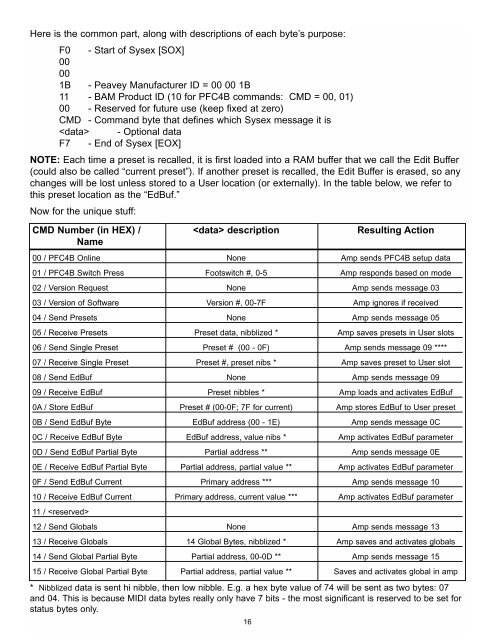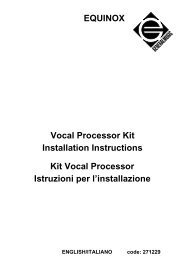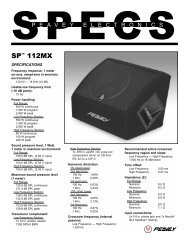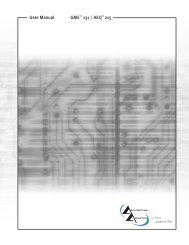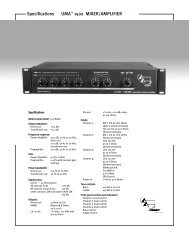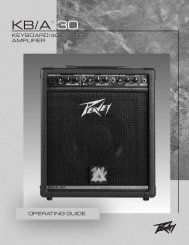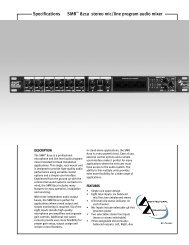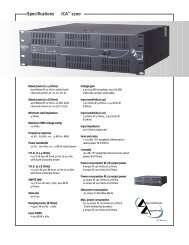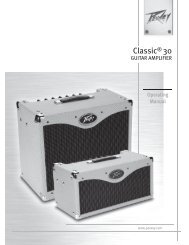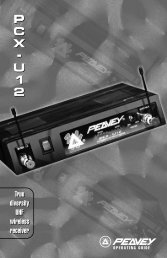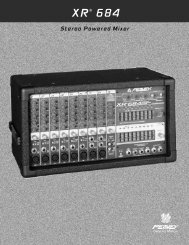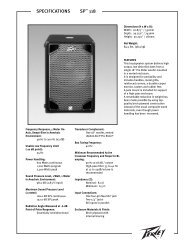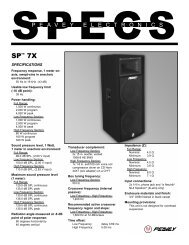You also want an ePaper? Increase the reach of your titles
YUMPU automatically turns print PDFs into web optimized ePapers that Google loves.
Here is the <strong>com</strong>mon part, along with descriptions of each byte’s purpose:<br />
F0 - Start of Sysex [SOX]<br />
00<br />
00<br />
1B- <strong>Peavey</strong> Manufacturer ID = 00 00 1B<br />
11 - <strong>BAM</strong> Product ID (10 for PFC4B <strong>com</strong>mands: CMD = 00, 01)<br />
00 - Reserved for future use (keep fixed at zero)<br />
CMD - Command byte that defines which Sysex message it is<br />
- Optional data<br />
F7 - End of Sysex [EOX]<br />
NOTE: Each time a preset is recalled, it is first loaded into a RAM buffer that we call the Edit Buffer<br />
(could also be called “current preset”). If another preset is recalled, the Edit Buffer is erased, so any<br />
changes will be lost unless stored to a User location (or externally). In the table below, we refer to<br />
this preset location as the “EdBuf.”<br />
Now for the unique stuff:<br />
CMD Number (in HEX) / description Resulting Action<br />
Name<br />
00 / PFC4B Online None Amp sends PFC4B setup data<br />
01 / PFC4B Switch Press Footswitch #, 0-5 Amp responds based on mode<br />
02 / Version Request None Amp sends message 03<br />
03 / Version of Software Version #, 00-7F Amp ignores if received<br />
04 / Send Presets None Amp sends message 05<br />
05 / Receive Presets Preset data, nibblized * Amp saves presets in User slots<br />
06 / Send Single Preset Preset # (00 - 0F) Amp sends message 09 ****<br />
07 / Receive Single Preset Preset #, preset nibs * Amp saves preset to User slot<br />
08 / Send EdBuf None Amp sends message 09<br />
09 / Receive EdBuf Preset nibbles * Amp loads and activates EdBuf<br />
0A / Store EdBuf Preset # (00-0F; 7F for current) Amp stores EdBuf to User preset<br />
0B / Send EdBuf Byte EdBuf address (00 - 1E) Amp sends message 0C<br />
0C / Receive EdBuf Byte EdBuf address, value nibs * Amp activates EdBuf parameter<br />
0D / Send EdBuf Partial Byte Partial address ** Amp sends message 0E<br />
0E / Receive EdBuf Partial Byte Partial address, partial value ** Amp activates EdBuf parameter<br />
0F / Send EdBuf Current Primary address *** Amp sends message 10<br />
10 / Receive EdBuf Current Primary address, current value *** Amp activates EdBuf parameter<br />
11 / <br />
12 / Send Globals None Amp sends message 13<br />
13 / Receive Globals 14 Global Bytes, nibblized * Amp saves and activates globals<br />
14 / Send Global Partial Byte Partial address, 00-0D ** Amp sends message 15<br />
15 / Receive Global Partial Byte Partial address, partial value ** Saves and activates global in amp<br />
* Nibblized data is sent hi nibble, then low nibble. E.g. a hex byte value of 74 will be sent as two bytes: 07<br />
and 04. This is because MIDI data bytes really only have 7 bits - the most significant is reserved to be set for<br />
status bytes only.<br />
16


